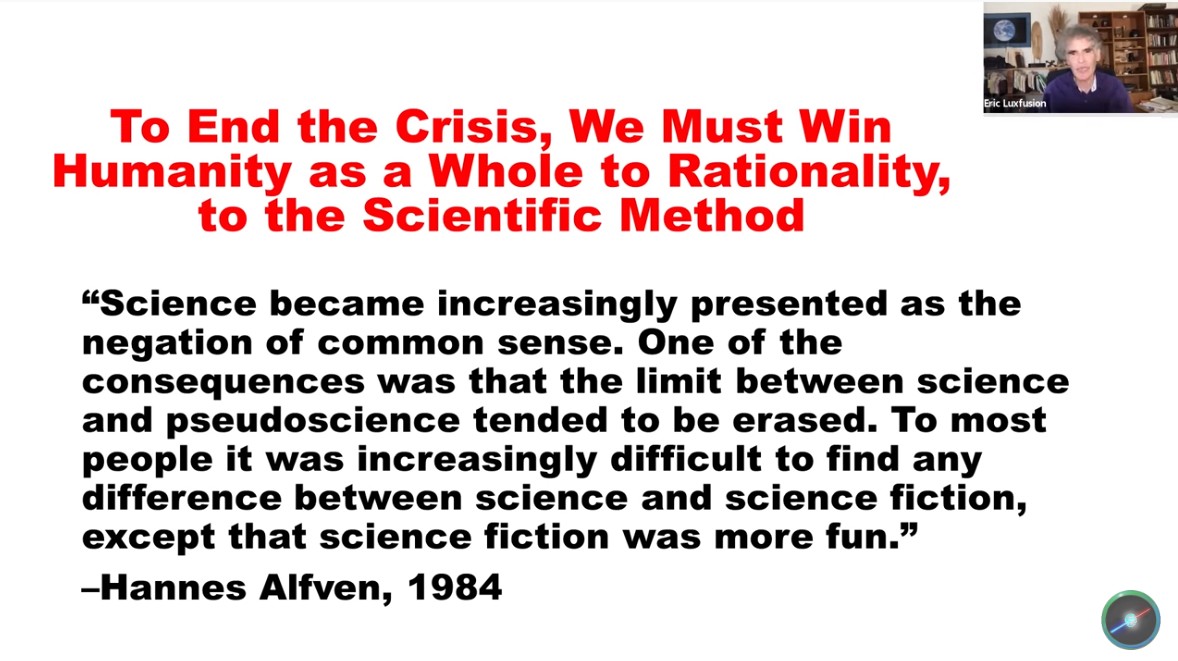 Click on Pic
Click on Pic
Fred Hoyle once said "anytime you point
a new telescope at the sky now you are only going to find what you already know is up there."
Has modern physics become complacent? New science is where the real opportunities lie, so we're focusing on
the holes in physics theory instead.
In Léon Brillouin's book
Relativity Reexamined we read on page 10 about the Theory of
General Relativity:
a splendid piece of mathematics built on quicksand and leading to more and more
mathematics about cosmology (a typical science-fiction process). And on page 31 it reads:
Einstein introduced a very heavy mathematical structure that goes much beyond any physical need.
A great deal of Big Bang cosmology is formulated in terms of this overly complicated (GR) mathematics.
One of our goals is to replace that overkill by mathematical machinery that is more easily understood
and maybe better balanced with empirical evidence as well.
However, quite in general it may be said that any theory of cosmology, whether standard or
non-standard, is close to fiction.
Reality is that which, when you stop believing in it, doesn't go away (: Philip K. Dick).
And the simple fact is that we don't really know where our believing stops.
Example given: How to measure a distance of one thousandth of the proton diameter?
Really?
General Relativity is rejected; Special Relativity is retained, though.
The reason is that the latter, contrary to GR, is consistent with Quantum Mechanics and - even better - contributes to it.
Unified Alternative Cosmology (UAC) starts with the assumption that the universe is infinite
in space and time. Because of Russel's Paradox and Infinitum Actu Non Datur this effectively means that
"There is no universe" at all; in the sense that there would exist something that contains
everything. Our infinite universe, according to Gauss' dictum, is just
a way of speaking.
Our theory then proceeds with a hypothesis by
Halton Arp
: the (rest) mass of atomic particles is increasing with (proper) time. Abbreviation:
VPM = Varying elementary Particle rest Mass. Arp's hypothesis is shown to be
compatible with a static Euclidean universe, which is eternal in "atomic time" and has moments of creation
(i.e. one or more beginnings) in "orbital time". In this model, gravitation is completely separated from
all other forces in nature; it is e.g. distinct from quantum mechanics and electrodynamics, meaning that
Grand Unified Theories are beyond the scope of UAC. Our steady-state universe is equipped with intrinsic
"cosmological" redshift in the first place. Another consequence of Arp's hypothesis is that all devices
for measuring length are shrinking, which is the same as saying that empty space is continuously expanding.
It will be proved that UAC and MOND
are in some sense equivalent. Therefore it's no such big surprise that we have a decent explanation
for the rotation curves of galaxies, without artificial assumptions such as dark matter. And there is
also an explanation for the Tully-Fisher relation.
A Basic Equation allows us to estimate reasonably well the magnitude of the secular retardation of the spin motion
of the Earth. The analysis of Seeliger's Paradox produces an extremely simple derivation of the
Pioneer anomaly as a side effect. Last but not least,
rejecting the ΛCDM model enables us to find a neat solution for the infamous Hubble tension.
So far so good about the Alternative. For the Unified:
just take a look at the person's names in the table of contents below.
| According to: | Gravitation: | Electrodynamics: |
| Barry Setterfield | Orbital time | Atomic time |
| Arthur Milne | Kinematic time | Dynamical time |
| Fred Hoyle | Einstein frame | Minkowski frame |
| H | C | if H then C |
| true | true | true |
| true | false | false |
| false | true | true |
| false | false | true |
This means that our theory can only be false if the Hypotheses are true while any of the Conclusions is false. So it is still true if the Hypotheses are false. Which is pretty good :-)
(*) Material conditional, Conditional Statements: if p then q, Propositional Logic and Redundancy.
Okay, no joking anymore. Is there any empirical evidence supporting the UAC theory? The answer may be surprising: